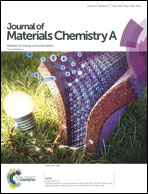CaI2: a more effective passivator of perovskite films than PbI2 for high efficiency and long-term stability of perovskite solar cells†
Abstract
A large number of previous studies demonstrate that excess PbI2 in perovskite films is essential for solar cells to achieve high efficiency due to defect passivation, but few studies consider its negative impact on the devices' long-term stability. Herein, we introduced CaI2 instead of PbI2 with much less additive content into the CH3NH3PbI3 (MAPbI3) film and obtained a dense, uniform and surface-smooth morphology with much enlarged crystal grains. It has been demonstrated that addition of only 0.5% CaI2 additive to MAPbI3 is enough to enlarge the average grain size from 260 nm to 550 nm; accordingly, the defect density is decreased from 5.76 × 1016 cm−3 to 3.35 × 1016 cm−3 and the photoluminescence (PL) lifetime is increased from 65 ns to 133 ns; as the reference, addition of 5% PbI2 additive to MAPbI3 results in an average grain size of 410 nm, a defect density of 4.06 × 1016 cm−3 and a PL lifetime of 98 ns. In all of these key parameters, CaI2 as a new passivator of the MAPbI3 film, is found to be more effective than conventional PbI2. As a consequence, the champion cell based on MAPbI3(CaI2)0.005 achieved a high efficiency of up to 19.3%, superior to those based on pristine MAPbI3 (16.1%) and MAPbI3(PbI2)0.05 (18.0%). In addition, 10 times less additive of CaI2 than PbI2 made the perovskite film much less deviated from the ideal stoichiometry of MAPbI3, which is found to be essential for the device to achieve long-term stability.

- This article is part of the themed collection: International Year of the Periodic Table : From Pb and Sn Perovskites to the Next Generation


 Please wait while we load your content...
Please wait while we load your content...